Mountain biking is an exhilarating and challenging sport that requires a well-functioning bike to navigate the rough terrain.
One of the most critical components of a mountain bike is the derailleur, which shifts the chain between gears to adjust the bike’s speed and power.
However, even the most high-quality derailleur can become misaligned or malfunction over time, making it difficult to shift gears smoothly.
BSXInsight will cover the step-by-step on how to adjust a derailleur on a mountain bike, including the tools you’ll need, common problems to look out for, and tips for achieving perfect gear shifts on your mountain bike.
What’s a Bike Derailleur?
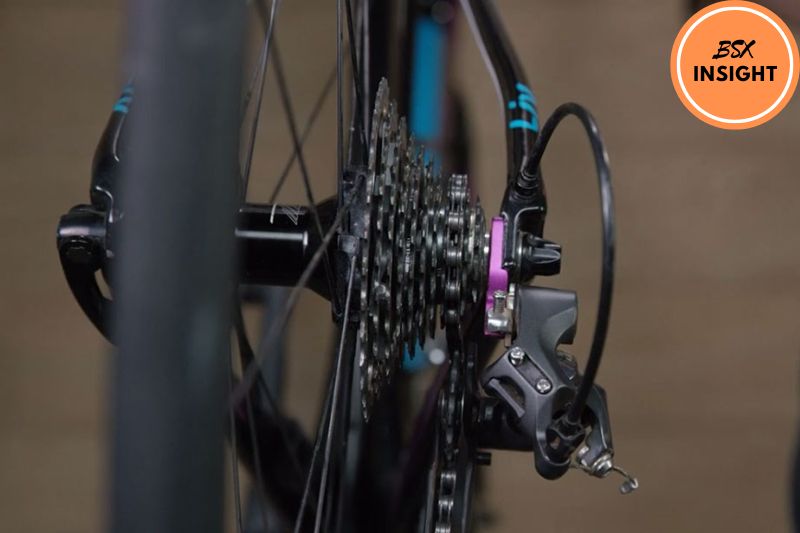
A bike derailleur is a critical component of a bicycle’s drivetrain that helps shift the chain between gears. The derailleur system is used in most modern bicycles and consists of two types of derailleurs – front and rear.
The front derailleur is responsible for moving the chain between the front chainrings, while the rear derailleur moves the chain between the rear cogs.
The derailleur system works by using a cable that connects to the shifter on the handlebars to move the derailleur. When the rider shifts gears, the shifter pulls or releases the cable, causing the derailleur to move and shift the chain to the desired gear.
The derailleur system is essential for mountain biking, where riders encounter a variety of terrains and gradients that require different gear ratios.
By shifting gears, the rider can adjust the bike’s speed and power to navigate the terrain more efficiently.
Derailleurs come in various shapes and sizes, depending on the type of bike and its intended use.
Road bikes, for example, typically have a more compact derailleur system that is designed for smooth and efficient shifting on paved roads. In contrast, mountain bikes require a more robust derailleur system that can handle the demands of off-road riding.
How To Adjust A Derailleur On A Mountain Bike?
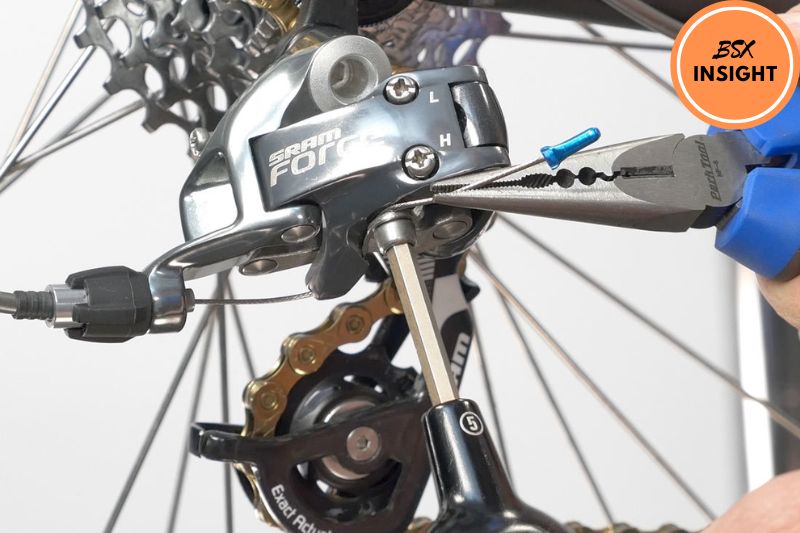
Adjusting a derailleur requires some patience and trial and error. Here are the steps to follow:
Adjusting the H-limit screw
The H-limit screw controls how far the derailleur moves toward the smallest cog on the rear cassette.
If the chain is skipping off the smallest cog, turn the H-limit screw clockwise until the derailleur stops moving and is in the correct position. If the derailleur doesn’t reach the smallest cog, turn the screw counterclockwise.
Tightening the cable
Check the cable tension by shifting the bike to the smallest cog on the rear cassette. The cable should be tight enough to keep the derailleur in place but not too tight that it causes the derailleur to skip gears.
If needed, use a screwdriver to turn the barrel adjuster on the shifter to tighten the cable.
Adjusting the cable tension
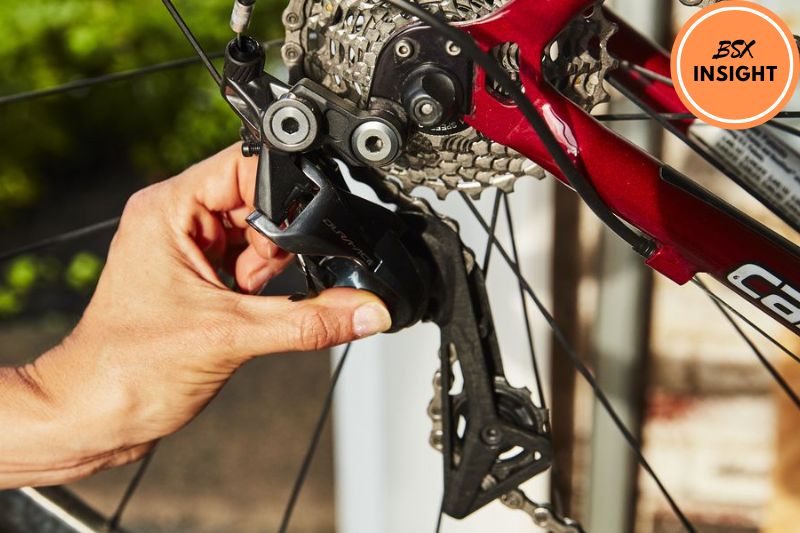
If the chain does not shift smoothly between gears, the cable tension may be too loose or too tight.
Shift the bike to the middle gear on the rear cassette and turn the barrel adjuster on the derailleur until the chain shifts smoothly between gears. If the chain is not shifting smoothly up or down, you may need to adjust the cable tension.
Shifting it up
If the chain does not shift up to the next larger cog, it may be due to a slack cable.
Shift down to the smallest cog on the rear cassette and loosen the cable tension by turning the barrel adjuster counterclockwise until the chain moves to the next larger cog.
Adjusting the B-tension screw
The B-tension screw controls the distance between the jockey wheel on the derailleur and the cogs on the cassette.
If the derailleur is making noise or the chain is slipping, adjust the B-tension screw by turning it clockwise to increase the distance or counterclockwise to decrease it.
6 Tips to Adjust the Rear Derailleur on Your Mountain Bike
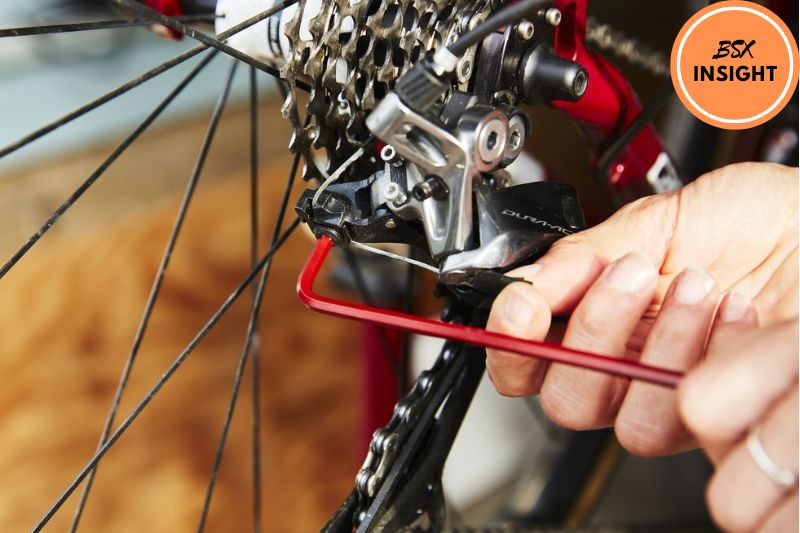
Mountain bikes are built to endure rough and challenging terrain, and the rear derailleur is responsible for providing smooth and reliable gear shifting.
However, over time, the derailleur may become misaligned or worn out, which can cause issues with shifting. Here are six tips to help you adjust the rear derailleur on your mountain bike:
Properly Aligned Derailleur
Ensure that the derailleur is correctly aligned with the cassette. You can do this by checking that the derailleur hanger is straight and that the derailleur itself is parallel to the cassette. If it’s not, adjust the derailleur hanger or use a derailleur alignment tool.
Set The Limit Screws With The Gear Cable Disconnected
Before you adjust the cable tension, set the limit screws with the gear cable disconnected. The limit screws control how far the derailleur moves towards the smallest and largest cogs. Use a screwdriver to adjust the screws until the derailleur lines up correctly with the cassette.
Tighten The Cable Adequately And Attach It To The Body
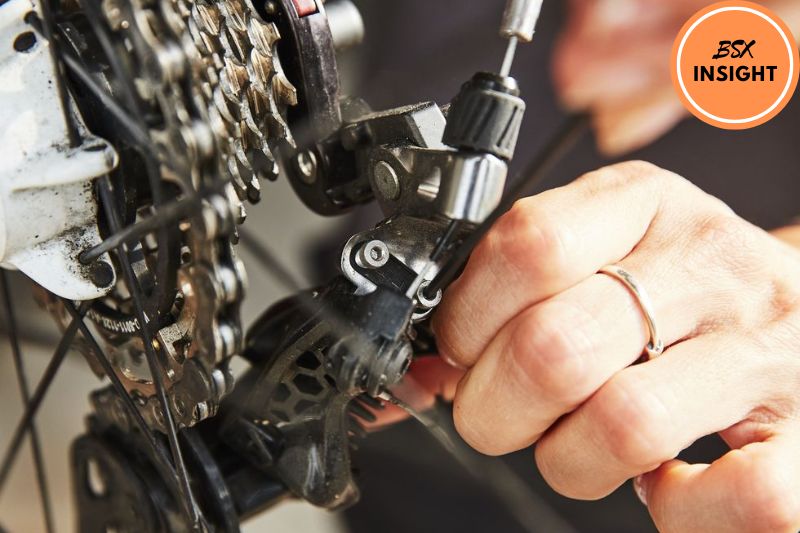
After setting the limit screws, reattach the gear cable to the derailleur body and tighten it adequately. Make sure that the cable is routed correctly and that there is no slack.
Moving Up The Cogset Is Okay But Moving It Down Is Not
When shifting up the cassette, the derailleur should move the chain smoothly and quickly. However, when shifting down, the chain should not drop suddenly. If it does, adjust the cable tension by tightening it slightly.
A Grinding Sound On The Largest Cog
If you hear a grinding sound when you’re on the largest cog, the B-tension screw may need to be adjusted.
Turning the screw clockwise will increase the clearance between the upper jockey wheel and the cog while turning it counterclockwise will decrease it.
Skipping While Riding Under Load
If your chain is skipping when you’re riding under load, the problem is most likely with the cable tension. Try tightening the cable slightly and test it again.
What If The Derailleur Shifts Two Sprockets With One Click?
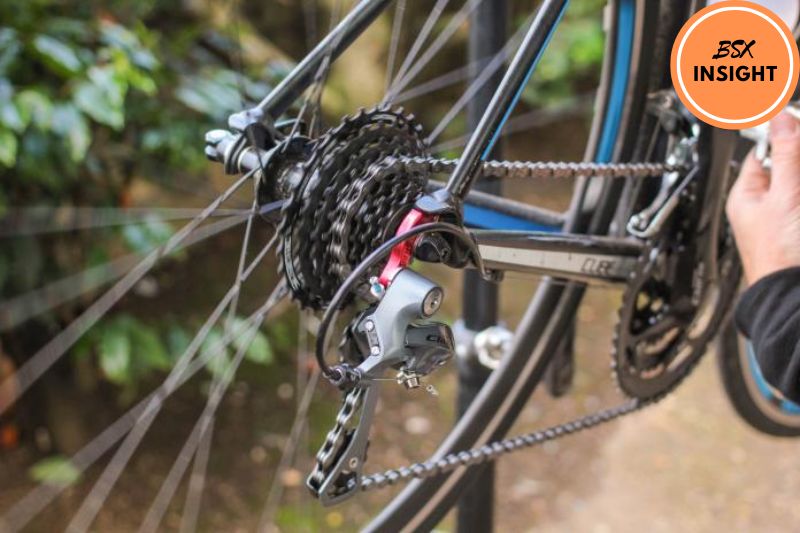
If your bike’s derailleur shifts two sprockets with one click, it could be due to a few different factors. Here are some possible reasons and solutions:
Cable Tension
One of the most common causes of derailleur shifting two sprockets with one click is incorrect cable tension.
If the cable is too tight, the derailleur may skip over one sprocket and move to the next one. Adjust the cable tension using the barrel adjuster until the shifting is smooth and accurate to fix this.
Worn Out Shifter
Another possible cause of the derailleur shifting two sprockets with one click is a worn-out shifter.
Over time, the shifter mechanism can become worn or damaged, which can affect the accuracy of the shifting. In this case, you may need to replace the shifter to fix the problem.
Damaged Derailleur
A damaged or bent derailleur hanger can also cause the derailleur to shift two sprockets with one click.
This can happen if the bike has been involved in a crash or if the derailleur hanger is bent during transport. To fix this, you may need to replace the derailleur hanger or take your bike to a professional bike mechanic for assistance.
Incorrectly Installed Derailleur
If the derailleur has been installed incorrectly, it can also cause the bike to shift two sprockets with one click.
This can happen if the derailleur is not aligned properly with the cassette or if the limit screws are not set correctly. To fix this, you may need to re-install the derailleur or have it adjusted by a bike mechanic.
FAQs
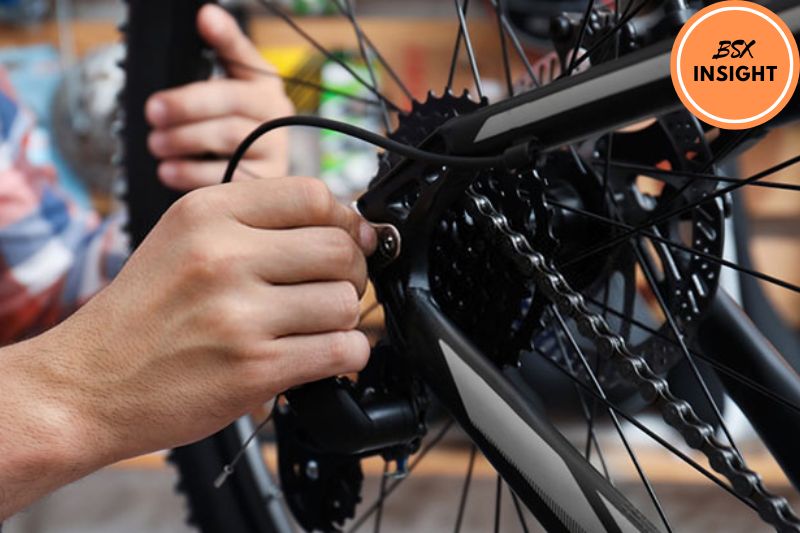
How do I know if my derailleur needs adjustment?
Signs that your derailleur may need adjustment include difficulty shifting gears, chain skipping or jumping, or the chain falling off the chainrings or cassette. You may also notice unusual noises or resistance while pedaling.
Can I adjust my derailleur without any special tools?
While it is possible to make some basic adjustments to your derailleur without any special tools, it’s recommended to have at least a set of Allen wrenches and a cable cutter for more advanced adjustments.
Is it better to adjust the derailleur on a stationary bike stand or while riding the bike?
While it is possible to adjust the derailleur while riding the bike, it’s recommended to use a stationary bike stand if available.
This will make the adjustments easier and safer since you don’t have to worry about balancing the bike while making adjustments.
Can I adjust the derailleur myself, or should I take it to a bike shop?
Basic adjustments like tightening the cable or adjusting the limit screws can be made at home with some patience and practice.
However, if you are unsure or uncomfortable with adjusting the derailleur, it’s best to take your bike to a professional bike shop for assistance.
How often should I adjust my derailleur?
How often you need to adjust your derailleur depends on various factors, such as how frequently you ride your bike, the terrain you ride on, and the conditions in which you ride.
As a general rule, it’s a good idea to check and adjust your derailleur every few months or as needed.
Conclusion
Adjusting the derailleur on your mountain bike is an essential skill for any rider. A well-adjusted derailleur will ensure that you can smoothly shift gears and enjoy a comfortable and efficient ride.
By following the steps outlined in this article, you can easily adjust the derailleur on your mountain bike and troubleshoot any issues that may arise. With a little practice, you’ll be able to fine-tune your bike’s shifting to suit your riding style and preferences.

